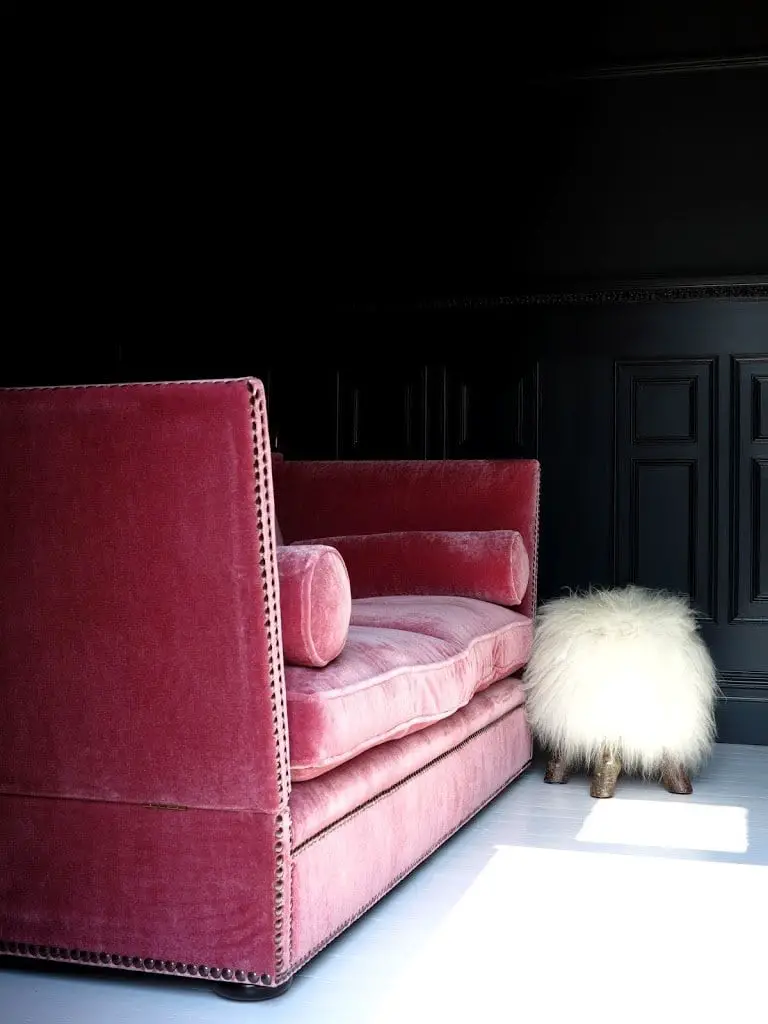(via Greige Design)
At Oxbow we are starting our month-long final project, which begins with a research paper. My passion for interior design has really solidified during my time here and I have devoted my whole project to exploring my passion for interior design and architecture and its psychological significance. The following is the introduction to my research paper.
The home was built by my great-grandfather, a New England style saltbox with grey clapboard siding and black shutters. The windows and doors were white, the surrounding magnolias and ornamental cherry trees reflecting varying shades of green. Long garden beds spanned the backyard, lined with boxwoods. Warm reds, oranges, and yellows fill the spaces of my memory, sunlight flashes through my mind’s eye, and the chill of the stone of the kitchen floor can almost be felt again. Many of my childhood memories are rooted in this house, the new occupants of a past reality. Our old home retains this emotional value that can only be contained within a built environment of architecture and interiors. It was our domestic landscape, to which all my experiences took hold. It reflected our family in the heirloom furniture and in the residue of our life that pervaded every space. It reflected the light that shaped my imagination, it held the air that suspended a symphony of smells that was uniquely ours. This house was more than just wood and cement and painted walls, for it represented much more than a family home. The house was represented a sense of place that can only take root in a built environment that exists in harmony with the emotional needs of its occupants.
Architecture and interior design are in a permanent relationship, one cannot successfully exist without the others’ support. The architecture interacts with its natural surroundings and the interior with both the surroundings and the architecture itself, in a synergy that comprises the manmade landscape. All of the elements of architecture and interior design fulfill psychological goals that stem from the intended purpose of the building. The office building is created to make the most efficient work space for employees. Though this efficiency sounds strictly utilitarian, it cannot be detached from the goal of optimal emotional health of the workers, which is closely tied to their conscious or unconscious reaction to their environment. Like any art, architecture and interior design are not necessary to life itself, but can enhance it in a way that make it necessary in a philosophical sense.
Architecture and interior design are the manmade skeletons for light and space, arguably the most evasive and mysterious substances. Our design are often our best attempts to harness their qualities in new ways and address in our psychological goals in the process. Light can be characterized in color, which is both physical and non-physical, found on every surface and in the warm streams of sunlight floating through a window. Though there is no common experience for color, many studies show that there are common associations with color that are ingrained in our subconscious from birth. Color is the language of interior design, a conversation with our psyche that manifests in spaces that can serve both common and individual needs depending on the purpose of the structure. Color psychology is the study of this emotional and behavioral response, a response that stems from a mix of instinctual and experiential interactions with color in our world. Given this power, color has deep symbology based on its context and can be used as a tool to craft spaces that address our emotional health, as well as aesthetic pleasure.
Architecture and interior design reflect not only psychological desires, but can reflect a whole culture through color trends and design elements. The 1950’s was a pivotal time in the shaping of our contemporary domestic form, as free standing houses started becoming more affordable due to mass-production of homes in suburb-style communities. As the highway system expanded with President Eisenhower’s Federal-Aid Highway Act, the house became detached from the workplace and homes became the centers of domestic life, with new suburban forms redefining home as semi-rural retreats. The home became more closely tied with nature and yards became standard. Midcentury design became simple, streamlined, smooth and shiny with chrome accents. The 1950’s flung imagination into outer space, taking modern design with it. This new “space-age” style represented the technological progress of the era and became iconic for the 50’s. Reflection of culture represents an important part of design, as it is constantly changing as social and technological progress marks new trends and sparks design innovations. A mix of historical elements and contemporary reflections ties tells a narrative of culture through the man-made landscape.
With a perspective on both psychological and historical significance, architecture and interior design weave together stories about both the user and their past, of contemporary culture and modern history. Whether a home is intentionally decorated or not, it is representational of a family’s culture and history and is symbolic of a starting point. Homes create a sense of place, which create the foundation for solidarity. I attribute my solidarity in character to the structure of my family home to provide the domestic context that I need to frame the rest of my life. Both architecture and interior design provide the foundation for our experiences, the structure to hold our dreams and the interiors for our memories to latch on to, and it is vital that these art forms are accessible so that the opportunity to ground oneself and our culture in design is not lost.

